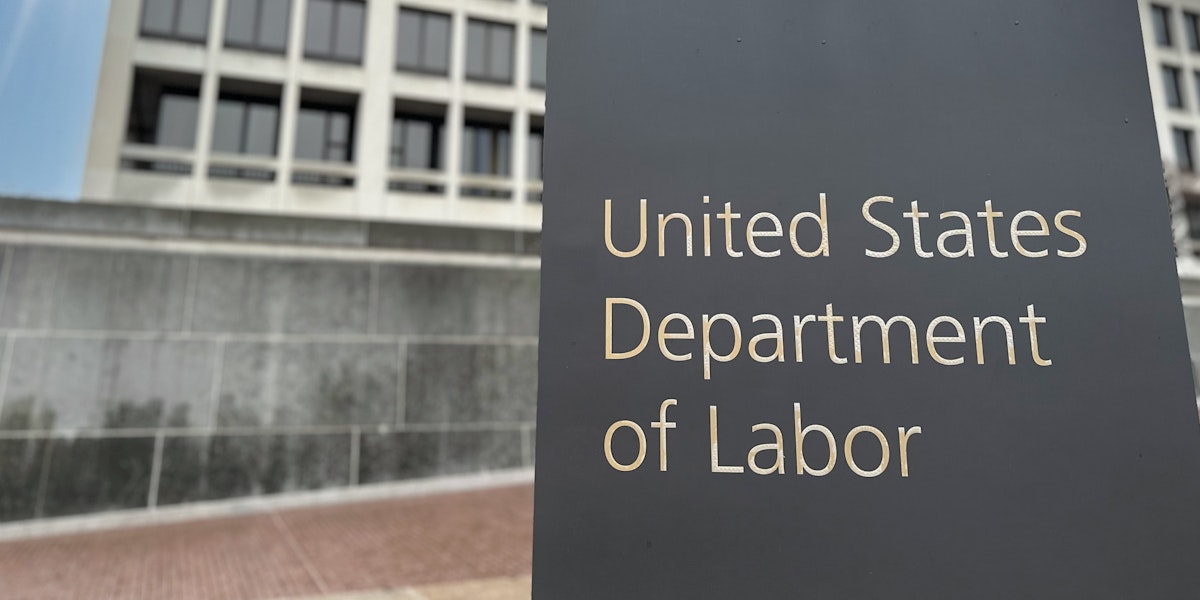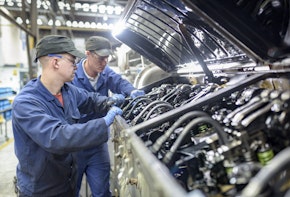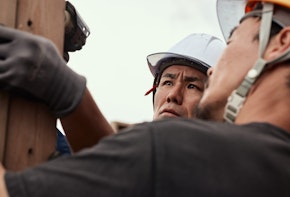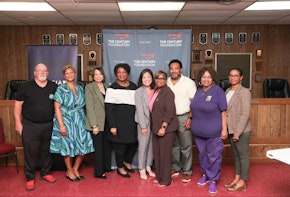Imagine this:
- Thirteen-year-old children working the night shift cleaning the kill floors of meatpacking plants, their small hands barely able to hold the tools they are required to use.
- Working people putting in fifty-hour workweeks and getting paid for just a fraction of the hours they worked.
- Hardworking coal miners working underground, forced to travel miles in mines that haven’t had safety inspections.
- Retirees who worked hard all their lives losing their nest eggs due to irresponsible decisions by the managers of their retirement plan.
These are the nightmares that could become the norm in a country without a strong U.S. Department of Labor (DOL).1
Under President Biden, the most pro-labor president in our nation’s history, we met challenges like these head-on and won. In communities across the country, we stopped corporations from exploiting children and sent a message that illegal child labor will not be tolerated. We recovered over $1 billion for workers who had been denied a just day’s pay for a hard day’s work.2 We prioritized hiring and training inspectors to keep working people safe on the job and advisors to hold health insurance plans accountable. We made sure over a million workers and retirees covered by struggling pension funds could retire with the full benefits they earned.
That work will all be for naught if the Department of Labor is stripped and sold for parts to benefit corporations looking to pad their pockets at workers’ expense. The DOL is facing significant cuts to staffing3 at the hands of the current administration’s chainsaw, via Elon Musk and the Department of Government Efficiency (DOGE). Already, over forty offices that inspect mines and other workplaces for safety are being closed, and they’re just getting started. These Elon Musk-cuts will be devastating for communities all across the country—not only for workers but for employers, for children, and for families.
The call for extreme cuts at DOL and other agencies across the government has been justified by calling the beneficiaries of these agencies’ work “radical interest groups.”4 Let’s take a look at who these “radical interest groups” who depend on a strong DOL are: workers on construction sites who should have fall protection; community college students looking for a job; patients waiting for a heart transplant; firefighters and first responders injured on the job; nursing mothers who return to work; employers who need a skilled workforce; child care providers who enable parents to go to work; home care workers who help parents and grandparents age with dignity; mayors who care about economic development and putting residents to work; governors who want a strong safety net for working people who face unemployment through no fault of their own; and families devastated by fires, hurricanes, and other natural disasters.
This report explores the possible impact that deep cuts in resources and personnel would have on the department’s ability to protect workers, support working families, and promote economic growth.
Worker Safety
The DOL enforces laws that make sure workers come home healthy and safe at the end of every work shift. While Elon Musk is set to shut down offices and eliminate inspectors, the reality is this: too many workers already lose their limbs, their lungs, and even their lives on the job due to unsafe working conditions. For many of those workers, DOL is their first and last line of defense on safety, and any cuts will only further imperil their lives.
Occupational Safety and Health
The Occupational Safety and Health Administration (OSHA) was established to protect workers from preventable injuries and fatalities on the job and to ensure healthy workplaces were the norm. In 1970, the year before OSHA started operating, there were eighteen deaths per every 100,000 workers in the United States for a workforce that was just under 80 million. Today, there are 3.5 worker deaths for every 100,000 workers in a workforce of nearly 300 million. In other words, while the workforce has grown by nearly 400 percent, the number of worker deaths has plummeted. Far from waste, fraud, and abuse, OSHA is an example of exactly what government exists to do: protect people from abuse.
During the Biden administration, DOL made enforcement a priority and undertook significant initiatives to improve worker safety, including the following:
- Maximized penalties for violations of workplace safety laws, including a record number of cases involving penalties for egregious violations.5
- Attacked corporate-wide practices that harmed workers, rather than viewing cases as isolated incidents; this included expanding the severe violator program, and using stronger, corporate-wide settlements to obtain lasting safety improvements.
- Instituted targeted awareness and enforcement campaigns for key workplace safety issues such as heat, silica, falls in construction, combustible dust, and injuries in the food processing and warehouse industries.
The Department of Labor has invited families who had lost loved ones to workplace tragedies to come to Washington, D.C. each year on Workers Memorial Day, a day set aside to commemorate those who have lost their lives on the job, most recently in April 2024.6 It is heart wrenching to hear their stories, like that of young Samantha, who had never met her father because he left for work one day while her mother was pregnant and he died on the job. The DOL created a community for those families to grieve together and to speak out to highlight the importance of worker safety. Samantha’s mom, Wanda, now serves as vice president of the United Support and Memorial for Workplace Fatalities. To be perfectly clear: cutting DOL means more avoidable tragedies, more funerals, and more daughters like Samantha who grow up without a parent.
OSHA is currently dramatically under-resourced. Today, there is only one OSHA compliance officer for every 80,000 workers.7 Gutting staffing at the Department of Labor would exacerbate this crisis. Already, DOGE has eliminated the National Institute of Occupational Safety and Health that provided a research basis for worker safety, and the worst is yet to come.8
Mine Safety
Mine safety was once such a big concern that a separate agency was created within the DOL to protect miners. In 1977, the Mine Safety and Health Administration (MSHA) was created by a law known as the Mine Safety and Health Act. This law provided for regular inspections and enforcement to address the nation’s history of mining disasters and fatalities. Because of the powers given to MSHA, mining fatalities have dropped significantly, from 273 in 1977 to 28 last year.9
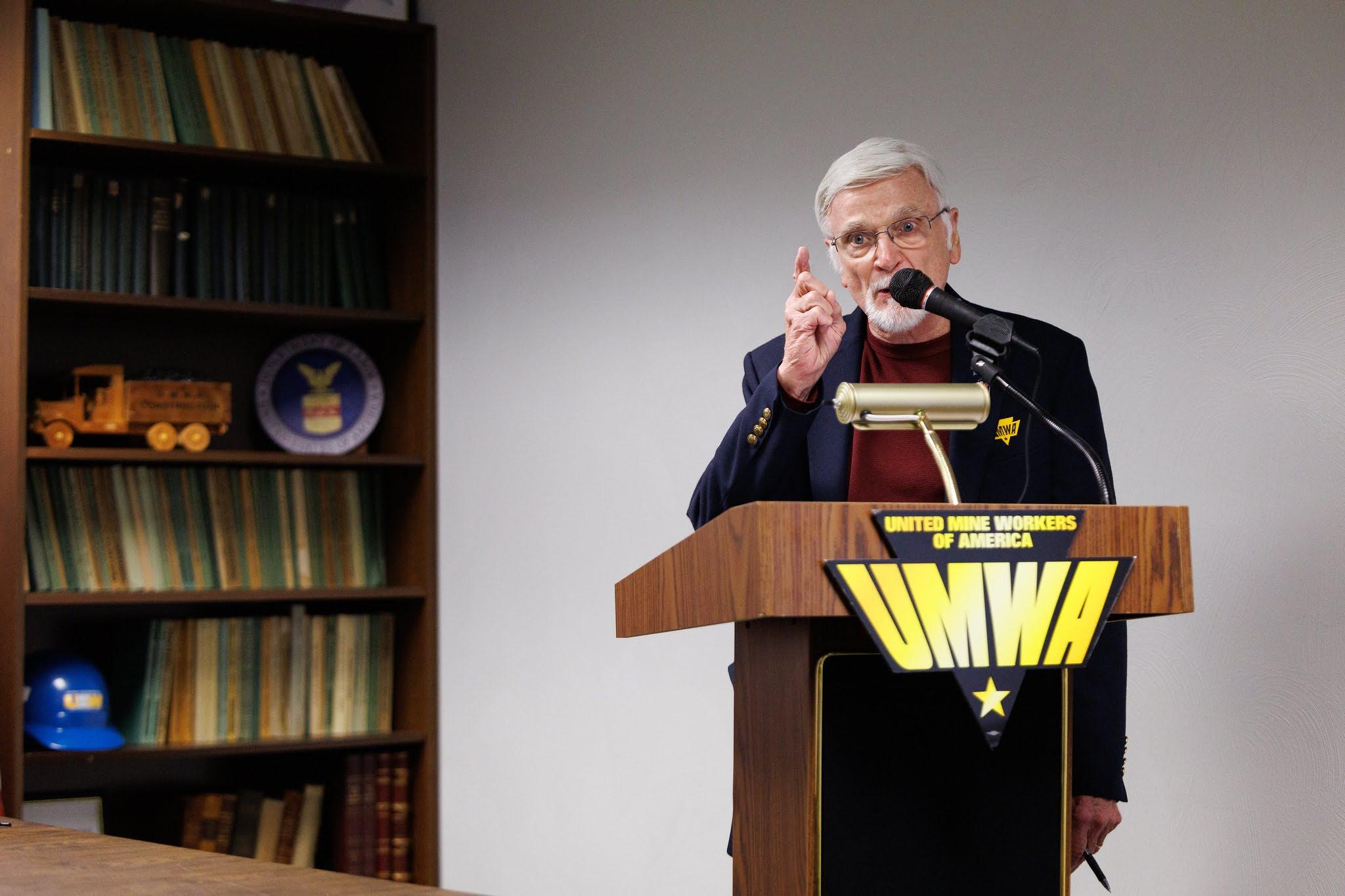
Miners die too often from exposure to silica, which causes silicosis, as well as other respiratory diseases, cancer, and other life-threatening illnesses. In Central Appalachia, an estimated one in five long-tenured coal miners have black lung disease. That’s one in five who struggle to get through a phone call or play with their grandkids without losing their breath, one in five whose life expectancy is cut down by an average of twelve years.
Under the Biden administration, DOL made significant strides to keep miners safe. The department:
- prioritized hiring and training MSHA inspectors;
- unleashed the power of MSHA by using all of its tools, including “pattern of violations” and “impact inspections” designed to stop chronic violators from getting away with practices that prove devastating to mining communities; and
- released a new standard to lower miners’ exposure to respirable crystalline silica.10
In 2010, an explosion at the Upper Big Branch mine took the lives of twenty-nine miners. An investigation found MSHA had issued over 500 citations for violations at the Upper Big Branch mine the year before but could have done more to prevent the tragedy, specifically failing to use its power to fine the mine for flagrant and repeated violations. The reason for these shortcomings, the investigation concluded, was lack of adequate staffing at MSHA—the brain drain, disruption, and experience gap caused by staffing cuts in the years prior to the explosion.
“More people will be alive ten years from now than they would have been if it wasn’t for what we’ve done fighting for this rule… [The Biden administration and coal miners are] trying to save people’s lives. There’s never too much health and safety in the nation’s coal mines.”
UMWA President Cecil Roberts
As with OSHA, MSHA is already significantly understaffed: the agency has approximately 1,200 enforcement personnel to cover over 12,500 mines across the country. The cuts already begun by Elon Musk mean workers and miners in Alabama, Illinois, Ohio, Tennessee, and Texas—where cuts have already been made—will lose the local OSHA and MSHA offices that protect their communities.11
History has shown time and again how the work of OSHA and MSHA prevents workers from getting injured on the job and saves countless lives. It should not take another disaster like Upper Big Branch to prove the point.
A Fair Day’s Pay
Too many workers across the United States are victims of wage theft. They aren’t paid the wages they’re entitled to by law for their hard work. The DOL’s Wage and Hour Division (WHD) makes sure that earned wages go where they belong: in workers’ pockets. The federal minimum wage of $7.25 an hour must be paid for every hour a worker works. Overtime pay is required for many workers who work more than forty hours in a week. But without a strong DOL to hold employers responsible, there is no check on wage theft.
The DOL under the Biden administration put over $1 billion back into the pockets of workers whose employers had stolen from them. Through multiple initiatives, the DOL:
- cracked down on cases where employers lied to their employees by calling them independent contractors and saying they were therefore not entitled to the protections of federal minimum wage and overtime laws;
- protected workers who spoke up about unfair wages and working conditions from being fired or retaliated against on the job; and
- stood up for workers who were forced to sign arbitration agreements and waivers of their rights to bring a case with their co-workers—a practice that strips workers of their ability to sue their employers for breaking the law, but doesn’t stop the DOL from doing its job to protect workers from wage theft.
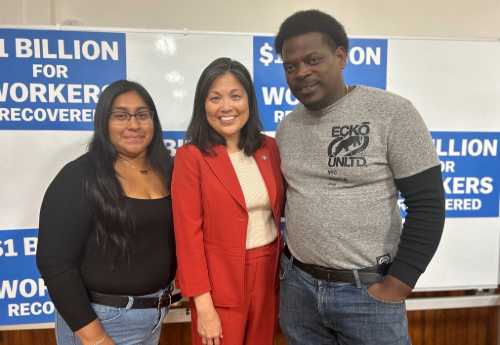
Roberto and Tania met waiting tables at a Pennsylvania restaurant. They worked long hours with no breaks.12 DOL found that their employer was stealing a portion of the tips they earned each day, and we recovered $1.3 million for all the workers in the restaurant. Roberto and Tania alone were owed over $60,000. That is lifechanging money for families. Roberto said he would use it to take Tania on the honeymoon they never had the money to take and to pay for their children to go to college.
Drastic staffing cuts at DOL would be a huge setback in the fight against wage theft. Fewer staff means fewer compliance actions, investigations, and targeted inspections. Fewer workers would get the back wages they are entitled to by law, jeopardizing these workers’ ability to pay for essentials such as rent, food, and child care.
Access to Health Care and Retirement
DOL plays a vital role in helping people understand their health plans, exercise their rights under the law, and recover benefits that were improperly denied. At a time when medical debt is a tremendous factor in the financial instability of families across America, DOL stands on the side of patients and families who should not have to face bankruptcy to get the critical lifesaving care they need.
DOL also helps to make sure that workers who have saved their entire lives for retirement get the benefits they earned and deserve and can retire with security and dignity. DOL’s enforcement and compliance efforts ensure that employers are properly funding their retirement plans and that plans are making sound financial decisions to protect workers’ hard-earned retirement assets.
All told, over 800,000 private retirement plans, 2.6 million health plans, and 500,000 other welfare benefit plans are overseen by DOL’s Employee Benefits Security Administration (EBSA) to ensure that patients and families get the benefits and coverage they’re entitled to and know what they’re going to be charged for. EBSA also oversees the federal Thrift Savings Plan, the largest retirement savings program with close to $1 trillion in assets, covering nearly 7 million participants. All of this is done with a staff of under 850 employees. Under the Biden administration, EBSA:
- recovered over $5 billion in payments due to employee benefit plans, plan participants, and plan beneficiaries, as part of responding to more than 740,00013 inquiries that came in to DOL’s benefits advisors from workers, retirees, family members, employers, plans, and plan service providers seeking assistance with their benefit plans;
- enforced mental health parity requirements so that employers and health plans understood their obligations to not create more restrictive barriers to accessing care for mental health and substance use disorder benefits than medical and surgical benefits;
- worked with the Pension Benefit Guaranty Corporation to provide special financial assistance to failing pension plans covering more than 1.2 million workers and retirees at risk of having their hard-earned pension benefits slashed;14 and
- protected retirement savers from financial professionals who provide investment advice that is in the interest of the financial professional, and not in the interests of the retirement saver so that workers can look forward to a secure retirement.
Erika, a young mother in Georgia, needed a new liver or she would not survive longer than a year. Five months after she began treatment to prepare for the transplant, the last thing she expected was her insurance company to tell her the transplant would not be covered. DOL got involved. The surgery was covered, and Erika’s life was saved.15
A retirement plan failed to contact workers to let them know they were owed benefits. A DOL benefits advisor connected with an 84-year-old Spanish-speaking participant who did not know he was entitled to retirement benefits from his prior job. Because of DOL, the retiree received information in Spanish, began getting his retirement benefits of $750 a month, and received $139,000 in back payments owed by the retirement plan.16
DOL’s investigators are already grossly outnumbered, with just one investigator for every 14,000 benefit plans.17 Further cuts will result in more financial crises for families and lower quality health care. Cuts to DOL would eliminate benefits advisors who answer phones and then advocate alongside desperate patients who have received a “coverage denied” letter from their health plan. Cuts to DOL would also slash the number of investigators who hold insurance companies responsible for systematically restricting access to health care by limiting the availability of network providers and making people jump through hoops just to get the care they need approved.
Protecting Workers Who Speak Up
When workers cannot report dangerous working conditions or hours worked without pay, they are even more vulnerable to exploitation. Too often, workers whose rights are violated fear speaking up because they don’t want to lose their jobs. Such retaliation is illegal. Without DOL, workers who are fired for reporting violations are often left with no recourse. When workers cannot speak up, it also hampers the ability of government to enforce the basic protections that workers should have on the job. Therefore, under the Biden administration, the DOL:
- vigorously enforced anti-retaliation provisions that protect workers who report labor law violations,18 including seeking expedited relief from courts to keep workers on the job when employers threatened to fire them or fired them for exercising their rights; and
- prosecuted employers for harassing workers who complained about not being paid their wages or who threatened workers and their families with violence for asking DOL for help.19
Good Jobs for All
Every worker should have a good job. Under President Biden, DOL invested in an interconnected infrastructure to connect people to good jobs and employers to the right people. Access to a good job isn’t just about job creation and training, though those are critical. It also requires knowledge about what jobs are available; transportation and child care so working people can get to and from training and job sites; and an honest assessment of barriers that some people face no matter how driven and disciplined they are—barriers like the long-standing exclusion of women, people of color, individuals with disabilities, and veterans from many jobs. These barriers don’t just hurt the individuals and communities excluded, they also deny employers the full talent they need.
This interconnected infrastructure comprises the nation’s roads and bridges of opportunity that connect people to good jobs and employers to good people. And this infrastructure is every bit as important as the physical roads and bridges in our communities. The DOL works in communities all across the country to build this opportunity infrastructure, including by distributing funds that connect people to good jobs.
Under the Biden administration, DOL:
- launched the Yes WIOA Can campaign20 to encourage states to creatively use funds for purposes like child care and transportation that can make opportunity pathways a reality for job seekers;
- issued new grants and technical assistance through the Employment and Training Administration (ETA) that expanded the numbers, quality, and access to pathways for registered apprenticeships;
- provided funds for labor-management partnerships where individuals, including those who face significant barriers to employment, can be trained in hospitality, nursing, arts and entertainment, climate resilience, or manufacturing and traditional trade occupations;
- awarded $46.5 million in grants to help young people in communities affected by violence and poverty connect to good jobs in their communities,21 breaking the cycle of violence and giving young people a viable path to mobility;
- funded Women in Apprenticeship and Nontraditional Occupations grants that have opened the door to good-paying construction jobs for women all across the country; with the DOL’s Women’s Bureau (WB)22 awarding over $21 million to twenty-six community-based organizations in every region of the country to allow women to fulfill their full potential and to work toward a day when no job will be “nontraditional” for women;
- provided critical data on women in the workforce, including economic disparities, workplace safety, and the impact of federal and state policies on working women and their families;
- served thousands of veterans and military spouses in the transition from military service to civilian life through provision of job training, wrap-around services, counseling, and needed supports for veterans to succeed; and
- expanded the Homeless Veterans Reintegration Program to support programs that help veterans experiencing or at risk of homelessness find meaningful employment and overcome barriers to entering and remaining in the workforce.
DOL’s Office of Disability Employment Policy (ODEP) was also a key part of the effort to promote good jobs, providing valuable resources, assistance, and best practices to help employers hire and retain workers with disabilities. The Biden administration saw more people with disabilities holding good jobs than any time in our nation’s history because of key programs like:
- the Competitive Integrated Transformation Hub,23 a one-stop shop for resources to help people with disabilities obtain competitive integrated employment; and
- the Job Accommodation Network (JAN),24 which provides free, confidential guidance on workplace accommodations, the Americans with Disabilities Act (ADA), and disability employment issues to employers, employees, job seekers, and service providers, and which responds to over 40,000 inquiries a year.
With support from JAN, a veteran with head and neck injuries worked with his employer to continue his job in graphic design with the use of low-cost accommodations like an ergonomic mouse and noise-canceling headset.25 In another instance, with guidance from ODEP’s JAN, an employer of a machine operator with arthritis provided new knobs and non-slip gloves—accommodations that enabled the worker to thrive.
The simple fact is that job seekers want to use their talents and skills to contribute to their communities and employers need workers like them. There is much more work to do to build an opportunity infrastructure that is truly connected and reaches all communities. Eliminating DOL services, funding support, assistance, and policies that expand opportunity to get ahead through a good job would undermine the economic security of millions of working people and jobseekers across the country, and would particularly impact key worker populations like women, workers with disabilities, and veterans, whose participation in the workplace is vital to the success of our economy.
Prioritizing Families
When workers do well, their families do better. The Department of Labor enforces laws that help workers be present for and enjoy their families. Through the Family and Medical Leave Act (FMLA), a father who takes time off to care for a loved one or to care for a newborn child has the right to return to his job. Other federal laws recognize what workers with families need to thrive, such as the law that provides that a nursing mother who returns to work must be given space and time to express breast milk at work. Under the Biden administration, DOL:
- educated employers and workers about these requirements, assisted with compliance, and ensured that workers can exercise these rights;
- worked with employers to provide time and space for working mothers to express breast milk in the workplace;
- provided, through the Women’s Bureau, research and grants that have been invaluable to state policymakers in passing state-level paid leave programs across about a dozen states, giving nearly 50 million workers paid leave;26 and
- helped craft a Presidential Memo for the thirtieth anniversary of the FMLA, in which President Biden called on federal agencies to develop unpaid leave for federal employees in their first year on the job and instructed the Office of Personnel Management to recommend policies to offer additional leave for victims of gender-based violence and harassment.
Candace Gardner, who works for a local government in Alabama, applied for and received FMLA approved leave for a medical condition. When her time away from work ended, instead of reinstating her, instead of returning her to her job she was fired. She lost her income and her health insurance. After DOL got involved, the employer admitted that Gardner’s medical restrictions did not prevent her from doing her job. The employer gave Gardner her job back and was required to pay her more than $42,000, including back wages, medical expenses, and other expenses incurred while the employer refused to reinstate her. Additionally, her sick leave and annual leave accounts were restored for the time she was denied the opportunity to work.27
Without the DOL’s outreach, education, assistance, and enforcement, family members would have to make the untenable choice between spending time with loved ones who need care and keeping their jobs; nursing mothers who return to work would have to express milk in a bathroom stall or on the shop floor. Working people deserve better than that.
Combating Discrimination and Providing Wage Security in Federal Contracting
Federal contractors must comply with requirements that ensure federal funds also benefit communities and not just private corporations. Up until January 2025, when President Trump rescinded the executive order that created the DOL’s Office of Federal Contract Compliance Programs (OFCCP) forty years ago, OFCCP enforced the requirement that federal contractors comply with anti-discrimination laws by actively recruiting women and people of color and developing affirmative action plans. Contractors were also prohibited from discriminating on the basis of race, color, religion, sex, sexual orientation, gender identity, national origin, disability or status as a protected veteran. Through the OFCCP, DOL collects wages for workers who were discriminated against and demands an end to discriminatory practice.
In 2022, after a DOL investigation, LinkedIn agreed to pay $1.8 million in back wages and interest to over 600 female employees who had been subjected to discriminatory pay practices. The company also agreed to evaluate its compensation policies and practices over the next three years to ensure compliance with its obligations as a federal contractor.28
With over 20 percent of the American workforce employed by federal contractors, the elimination of anti-discrimination protections and the agency that enforced them gives companies like Tesla and Amazon (both recipients of tens of millions in federal funds) a free pass to profit from public funds while engaging in unchecked discrimination.
DOL also enforces the requirement of fair wages for federal contractors, to ensure that federal contract work doesn’t undercut the wages of hardworking people in the local area. During the Biden administration, the DOL:
- ensured that many workers who work under contracts with the federal government received a raise up to a minimum wage of $17.75 an hour starting in 2025.
All workers—those employed on federal contracts as well as nonfederal workers in the local area whose wage standards are affected by contract work—rely on DOL to promote fair wages and livable wage standards. DOL has sole authority to ensure that federal agencies and their contractors are paying the wages that are owed to the workers who do critical work for the American people. Without this enforcement, workers who are cheated have nowhere to turn and federal dollars are turned into drivers of lower wages and a race to the bottom.
Safety Net during Hard Times
As demonstrated during the COVID-19 pandemic, the unemployment safety net for workers who lose their jobs through no fault of their own is a critical lifeline established in law. When that safety net fails, people suffer. Over the past four years, the Biden administration worked to build a system that would work when families need it most, particularly when unemployment is high and demands on the system spike. During times of low unemployment, as we experienced under President Biden, weaknesses in the unemployment insurance (UI) system are masked. But that is precisely the time to invest in the technology and other changes to transform the UI system into the system American workers deserve. During that time, the DOL:
- worked closely with states under the American Rescue Plan Act to repair and strengthen the grossly outdated UI system, including implementing hundreds of recommendations developed after careful consideration of each state’s needs; and
- developed identity verification and fraud prevention tools that could be used by all states.
Without the continued leadership of the DOL, states will be left to fend for themselves in building an unemployment insurance system that can scale its technology and processes to the next crisis.
The safety net provided by DOL goes beyond unemployment insurance as well. Firefighters, first responders, certain federal employees, and civil support workers for the U.S. military also rely on DOL’s services in times of personal economic crisis. These workers are entitled to workers compensation benefits for injuries incurred on the job. DOL’s Office of Workers Compensation Programs (OWCP) ensures these benefits are paid correctly, which ensures that such employees receive necessary medical treatments and rehabilitation services. OWCP also provides vocational training opportunities, to help workers find productive new employment consistent with their restrictions, and workplace safety training that aims to decrease the occurrence of injuries on the job for these unique populations of workers. Over the last few years, DOL has:
- improved services to workers by prioritizing efficiency in service delivery; claims processing that was once entirely done on paper has been automated, reducing errors, saving time, and preventing improper payments.
One group of employees who are entitled to benefits are those who have developed and maintained the U.S. nuclear arsenal. Exposure during their years of work means many of them need treatment for cancer and respiratory illnesses, the costs of which are covered by benefits that these workers rely on DOL to administer.29
Cuts to DOL would mean limited access to vocational training opportunities, hindering reintegration into the workforce for injured workers. Fewer claims examiners, nurse managers, and vocational rehabilitation specialists at DOL would increase long-term disability rates and drive up taxpayer costs, as even routine injuries would become prolonged disabilities. Cuts would weaken oversight on medical billing and provider fraud, increasing overbilling, overprescription, and unnecessary medical procedures.
The elimination of DOL’s workplace safety initiatives would result in more injuries—increased exposure for miners to silica and coal dust—which are not only devastating to those workers but also increase workers’ compensation costs for federal agencies. Reductions in research funding would halt progress on black lung prevention and treatment, leading to higher mortality rates among miners. Cuts to DOL might save a dollar today, but they will create problems that will cost far more to fix, in addition to the human costs of lost limbs, lungs, and lives.
Protecting Workers Around the World
The well-being of workers in the United States is connected to the well-being of workers abroad. The current administration’s claims that efforts to combat child labor, forced labor, and worker abuse around the world reflect an “America Last” strategy30 are both ignorant and harmful.
DOL provides resources, expertise, and analysis on international labor rights so the United States can monitor and enforce labor provisions in U.S. trade agreements and preference programs. This work supports American workers and businesses, which should not face unfair competition from companies overseas committing egregious labor violations, including child labor, forced labor, human trafficking, and interference with the freedom of association.
DOL’s Bureau of International Labor Affairs (ILAB) produces an annual report, “Findings on the Worst Forms of Child Labor,” that provides detailed information on the worst forms of child labor in 131 countries and territories.31 This report identifies gaps in legislation, enforcement, and practice and provides a roadmap to mitigating the problems. ILAB also publishes the “List of Goods Produced by Child Labor or Forced Labor” to inform businesses and consumers of trouble spots in global supply chains, and supports the U.S. government in identifying and rectifying egregious abuses. Finally, the “List of Products Produced by Forced or Indentured Child Labor” assists federal agencies in ensuring that the U.S. government is not purchasing products produced by forced child labor. During the Biden administration, DOL used these resources, along with the voice and leverage of the U.S. government, to lift up and strengthen workers’ rights around the world. Some of the accomplishments of this effort include:
- Ghana and Cote d’Ivoire have designed child labor mitigation efforts in response to DOL’s reporting;32
- Uzbekistan successfully addressed forced labor and child labor in the cotton sector33 and was able to end an international boycott of Uzbek cotton; and
- Argentina’s government and private sector built on DOL’s technical assistance programs in the blueberry sector, ensuring that children and teenagers had access to child care and enrichment programs, effectively addressing child labor in that sector.34
In partnership with the U.S. Trade Representative and the U.S. Department of State, DOL monitors Mexico’s compliance with the labor chapter of the United States–Mexico–Canada Agreement (USMCA), responds to violations arising through the agreement’s Rapid Response mechanism, staffs the relevant committees established by the USMCA, and drafts required reports to Congress. As a result, tens of thousands of Mexican workers have been able to improve their wages and working conditions at the bargaining table, not only helping workers in Mexico to achieve more economic security but also eliminating one source of unfair competition in the manufacturing sector for American workers.
At the General Motors plant in Silao, Mexico, which makes the Chevy Silverado and GMC Sierra pickup trucks, workers elected Alejandra, a single mother who had worked at the plant for almost twelve years, as their union’s secretary general in 2022. Alejandra is the first woman to lead a union in Mexico’s automotive sector. In the union’s first contract, the workers received an 8.5 percent pay increase, bigger bonuses and grocery vouchers, and a mandatory day off on Christmas Eve. The workers also now have a mechanism to address longstanding concerns around safety and scheduling with the employer.35
DOL’s work provides invaluable and irreplaceable information to global businesses, governments, workers, and consumers, all of whom desperately need more and better information about worker rights abuses in global supply chains. Without DOL’s work, the U.S. government could not adequately enforce the labor rights provisions in trade agreements and would lack critical information to negotiate effective labor provisions, tailored to each country and region, in trade agreements going forward. The most vulnerable workers in the world, including young children, would be more likely to suffer abuses. American businesses would lack the information they need to make informed decisions about sourcing and investment, American consumers would be more likely to unwittingly purchase products produced under inhumane conditions, and American workers would be forced to compete with foreign workers whose basic human rights have been violated. But on March 25, DOGE announced cuts36 to millions of dollars in ILAB grants that protect children and buttress American workers rights in the global economy.
Trump’s War on Workers
Too many working people struggle just to get by. Too many people work full-time, year-round and still can’t afford the basics, much less live a life of real security and comfort, while others want a good job and can’t find one. Too many get paid less than they earned, get injured on the job, do their level best to save for retirement and then find that those benefits aren’t there. And for businesses who play by the rules, too many find that when their competitors cut corners, they’re put at an unfair disadvantage. For many of these workers and employers, the Department of Labor is the agency in the federal government that says, “Not on my watch.”
The anticipated drastic cuts to the DOL are anti-worker. They are part of the administration’s war on workers that includes obliterating union protections, stripping workers of collective bargaining rights, and attacks on federal employees and the workers who depend on them. These cuts mean that workers will be even more vulnerable to exploitation and abuse.
Notes
- Thanks to Zack DiGregorio, Gayle Goldin, Lauren McFerran, Andrew Stettner, and Emma Trittin from The Century Foundation and Molly Bashay, Wendy Chun-Hoon, Kristin Garcia, Anupa Geevarghese, Chris Godfrey, Lisa M. Gomez, Thea Lee, Jessica Looman, Molly McCoy, Doug Parker, Taryn Williams, and Chris Williamson from the DOL46 team for their assistance with this report.
- Rebecca Rainey, “DOL Under Biden Touts $1 Billion Recovery in Wages, Damages,” Daily Labor Report, October 22, 2024, https://news.bloomberglaw.com/daily-labor-report/dol-under-biden-touts-recovery-of-1-billion-in-wages-damages.
- Stephen Fowler, “Federal agencies plan for mass layoffs as Trump’s workforce cuts continue,” National Public Radio, March 15, 2025, https://www.npr.org/2025/03/15/nx-s1-5328721/reduction-in-force-rif-federal-workers-job-cuts-musk-doge-layoffs.
- Russell T. Vought and Charles Ezell, “Memorandum: Guidance on Agency RIF and Reorganization Plans Requested by Implementing The President’s ‘Department of Government Efficiency’ Workforce Optimization Initiative,” U.S. Office of Management and Budget and U.S. Office of Personnel Managment, February 26, 2025, https://www.opm.gov/policy-data-oversight/latest-memos/guidance-on-agency-rif-and-reorganization-plans-requested-by-implementing-the-president-s-department-of-government-efficiency-workforce-optimization-initiative.pdf.
- Eric J. Conn and Darius Rohani-Shukla, “OSHA Expands ‘Instance by Instance’ Citation Policy: A Game Changer for OSHA Enforcement,” The OSHA Defense Report, February 6, 2023, https://oshadefensereport.com/2023/02/06/osha-expands-instance-by-instance-citation-policy-a-game-changer-for-osha-enforcement/.
- “US Department of Labor to honor workers whose jobs claimed their lives, recommit to protecting workers as nation marks Workers Memorial Day,” U.S. Department of Labor, April 17, 2024, https://www.dol.gov/newsroom/releases/osha/osha20240417.
- “Death on the Job: The Toll of Neglect, 2024,” AFL–CIO, April 23, 2024, https://aflcio.org/reports/dotj-2024.
- Jordan Barab, “The Purge: DOGE Kills NIOSH—And Workers,” April 1, 2025 https://jordanbarab.com/confinedspace/2025/04/01/niosh/.
- “Mine Safety and Health At a Glance: Fiscal Year,” U.S. Department of Labor, Mine Safety and Health Administration, 2024, https://www.msha.gov/mine-safety-and-health-glance-fiscal-year.
- “Department of Labor issues final rule reducing silica dust exposure, better protecting miners’ health from irreversible workplace illnesses,” U.S. Department of Labor, Mine Safety and Health Administration, April 16, 2024, https://www.dol.gov/newsroom/releases/msha/msha20240416; Ian Karbal, “New federal rule aims to limit coal miners’ exposure to silica dust, long linked to black lung disease,” Pennsylvania Capital–Star, April 16, 2024, https://penncapital-star.com/briefs/new-federal-rule-aims-to-limit-coal-miners-exposure-to-silica-dust-long-linked-to-black-lung-disease/.
- DOGE “Agency Leaderboard,” www.doge.gov/savings.
- Sarah Scinto, “NEPA workers among beneficiaries as US Labor Department recovers $1 billion in lost wages,” WVIA News–Pittstown (PA), November 13, 2024, https://www.wvia.org/news/local/2024-11-13/nepa-workers-among-beneficiaries-as-us-labor-department-recovers-1-billion-in-lost-wages.
- U.S. Department of Labor, Employee Benefits Security Administration. “EBSA Restores Over $2.4 Billion to Employee Benefit Plans, Participants and Beneficiaries.” Fact Sheet, U.S. Department of Labor, Employee Benefits Security Administration, 2021, https://www.dol.gov/sites/dolgov/files/ebsa/about-ebsa/our-activities/resource-center/fact-sheets/ebsa-monetary-results-2021.pdf. U.S. Department of Labor, Employee Benefits Security Administration. “EBSA Restores Over $1.4 Billion to Employee Benefit Plans, Participants, and Beneficiaries,” Fact Sheet, U.S. Department of Labor, Employee Benefits Security Administration, 2022, https://www.dol.gov/sites/dolgov/files/EBSA/about-ebsa/our-activities/resource-center/fact-sheets/ebsa-monetary-results-2022.pdf; U.S. Department of Labor, Employee Benefits Security Administration. “EBSA Restores Over $1.4 Billion to Employee Benefit Plans, Participants, and Beneficiaries,” Fact Sheet, U.S. Department of Labor, Employee Benefits Security Administration, 2023, https://www.dol.gov/sites/dolgov/files/EBSA/about-ebsa/our-activities/resource-center/fact-sheets/ebsa-monetary-results-2023.pdf; U.S. Department of Labor, Employee Benefits Security Administration. “EBSA Restores Nearly $1.4 Billion to Employee Benefit Plans, Participants, and Beneficiaries,” Employee Benefits Security Administration, 2024, https://www.dol.gov/agencies/ebsa/about-ebsa/our-activities/resource-center/fact-sheets/ebsa-monetary-results.
- “U.S. Department of Labor reports distressed pension assistance program has protected benefits for more than 1.2M workers, retirees, families,” U.S. Department of Labor, Employee Benefits Security Administration, November 1, 2024, https://www.dol.gov/newsroom/releases/ebsa/ebsa20241101.
- “Georgia Mom With Rare Form of Cancer Says Insurance Will Not Cover Life-Saving Liver Transplant,” Inside Edition, January 25, 2022, https://www.insideedition.com/georgia-mom-with-rare-form-of-cancer-says-insurance-will-not-cover-life-saving-liver-transplant.
- “EBSA Restores Nearly $1.4 Billion to Employee Benefit Plans, Participants, and Beneficiaries,” U.S. Department of Labor, Employee Benefits Security Administration, 2024, https://www.dol.gov/agencies/ebsa/about-ebsa/our-activities/resource-center/fact-sheets/ebsa-monetary-results.
- Lisa M. Gomez, “Statement of Lisa M. Gomez, Assistant Secretary of Employee Benefits Security Administration,” U.S. House Committee on Education and Workforce, Subcommittee on Health, Employment, Labor and Pensions, June 27, 2024, https://democrats-edworkforce.house.gov/imo/media/doc/gomez_testimony.pdf.
- “Field Assistance Bulletin No. 2022-02: Protecting Workers from Retaliation,” U.S. Department of Labor, Wage and Hour Division, March 10, 2022, https://www.dol.gov/sites/dolgov/files/WHD/fab/fab-2022-2.pdf.
- “Autoshop owner who dumped 500 pounds of oily pennies on ex-employee’s driveway is ordered to pay additional back wages,” CNN, June 21, 2023, https://www.cnn.com/2023/06/21/business/georgia-autoshop-lawsuit-settlement/index.html.
- “Yes, WIOA Can! Campaign,” WorkforceGPS and U.S. Department of Labor, Employment Training Administration, https://ywc.workforcegps.org/.
- “US Department of Labor awards $46.5M in grants to help young people in communities affected by violence, poverty find opportunities to succeed,” U.S. Department of Labor, Employment Training Administration, January 17, 2025, https://www.dol.gov/newsroom/releases/eta/eta20250117#:~:text=WASHINGTON%20%E2%80%93%20To%20overcome%20structural%20barriers,of%20community%20violence%20and%20help.
- “WANTO Grant Program,” U.S. Department of Labor, https://www.dol.gov/agencies/wb/grants/wanto.
- “CIE Transformation Hub,” U.S. Department of Labor, https://www.dol.gov/agencies/odep/program-areas/cie/hub.
- “Job Accommodation Network,” U.S. Department of Labor, Office of Disability Employment Policy, https://askjan.org/, accessed March 21, 2025.
- “Job Accommodation Network: Veterans and Service Members,” U.S. Department of Labor, https://askjan.org/topics/veterans.cfm, accessed March 26, 2025.
- “Key Facts: Paid Family and Medical Leave,” National Partnership on Working Families, November 2023, https://nationalpartnership.org/wp-content/uploads/key-facts-paid-family-and-medical-leave.pdf.
- Juan Coria, “How the Family and Medical Leave Act Delivered for Candice,” U.S. Department of Labor Blog, October 18, 2023, https://blog.dol.gov/2023/10/18/how-the-family-and-medical-leave-act-delivered-for-candice.
- “US Department of Labor, LinkedIn Corp. enter agreement to resolve alleged pay discrimination on behalf of 686 female workers in California,” U.S. Department of Labor, Office of Federal Contract Compliance Programs, May 3, 2022, https://www.dol.gov/newsroom/releases/ofccp/ofccp20220503#:~:text=Pay%20$1.8%20million%20in%20back%20wages%20and,gender%2Dneutral%20and%20make%20salary%20adjustments%20if%20not.
- “Department of Labor updates eligibility requirements for current, former nuclear weapons workers seeking benefits for beryllium sensitivity,” U.S. Department of Labor, July 15, 2024, https://www.dol.gov/newsroom/releases/owcp/owcp20240715.
- Lauren Kaori Gurley, “Trump administration moves to cut programs that fight child labor abroad,” Washington Post, March 27, 2025, https://www.washingtonpost.com/business/2025/03/27/trump-labor-department-international-child-labor/.
- “International Child Labor & Forced Labor Reports,” U.S. Department of Labor, Bureau of International Labor Affairs, 2023, https://www.dol.gov/agencies/ilab/resources/reports/child-labor.
- “International Child Labor & Forced Labor Reports,” Ghana, U.S. Department of Labor, Bureau of International Labor Affairs, https://www.dol.gov/agencies/ilab/resources/reports/child-labor/ghana.
- “Uzbek Cotton is Free from Systemic Child Labour and Forced Labour,” International Labour Organization, March 1, 2022, https://www.ilo.org/resource/news/uzbek-cotton-free-systemic-child-labour-and-forced-labour.
- “International Child Labor & Forced Labor Reports,” Argentina, U.S. Department of Labor, Bureau of International Labor Affairs, https://www.dol.gov/agencies/ilab/resources/reports/child-labor/argentina.
- Alejandra Quintero, “A First Contract for Mexican GM Plant’s Independent Union,” Labor Notes, https://labornotes.org/2022/06/first-contract-mexican-gm-plants-independent-union
- Department of Government Efficiency, X, March 26, 2025, https://x.com/DOGE/status/1904991292700123167.
